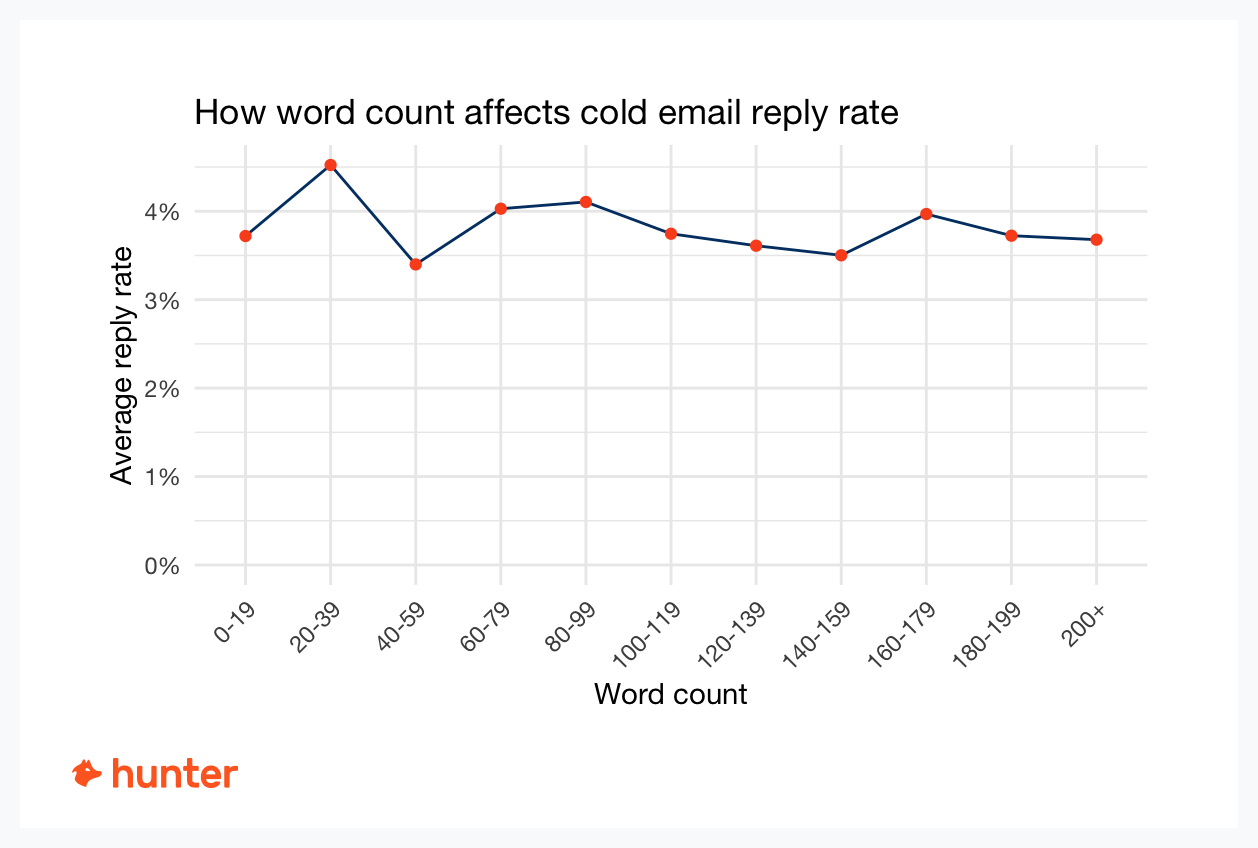What's the Best Word Count & Length for Cold Emails

How long should your cold email be to get the highest reply rate? The short answer is 20-39 words.
Based on an analysis of 34 million cold emails sent by Hunter users, cold emails that were between 20-39 words long got the highest average reply rate.

However, this doesn’t mean that if you adjust the email copy you’re currently using to match this word count range, your reply rate will improve.
In fact, my research shows that cold emails of different lengths can work well depending on the context.
In this article, I’ll guide you through research I’ve conducted to find the best word count for cold emails, and why you should take any such word count recommendations with a grain of salt.
Why existing research didn’t convince me
I’ve reviewed dozens of posts on the topic of word count in cold emails. Here’s what I found cited through and through:
- A 2016 study by Boomerang
- Data from Lavender.ai
- Personal experience
Boomerang and Lavender.ai research
The Boomerang study, which is widely cited by industry blogs, recommends using 50-125 words in your cold email. But there are two problems with this study:
- It’s outdated. Conducted in 2016 (and possibly using emails sent even earlier), it represents a snapshot of the past. The inbox reality in most industries is wildly different now than it was 8 years ago.
- This analysis didn’t focus on cold emails. Boomerang provides “meeting scheduling and email productivity” tools, which means its dataset must have contained a significant portion of warm email communications. And just look at the reported reply rates: Boomerang claims that emails in the 75-100 words range get a 51% response rate. If you ever sent a cold email campaign, you know this isn’t a realistic reply rate for email outreach at scale.
As for the Lavender.ai data, shared in an article on their blog as well as in the user dashboard, it also seems to include email communications beyond the first reply. While the Lavender results look more trustworthy (with reported average reply rates ranging from 15-25%), the response rates are still too high to represent just cold emails, as our user data shows.
To summarize, both studies I found, and especially the Boomerang study that’s cited on most industry blogs, don’t accurately reflect the reality of average reply rates. The datasets used must have contained other types of email communications.
Personal experience
While personal experience can be valuable, it must be contextualized to help you draw accurate conclusions for your own campaigns.
My experience sending cold email campaigns tells me that although word count is an important metric, it’s just one of multiple factors that influence your reply rates.
Seeing email copy used by someone else’s campaign and applying it to your campaign with a different mailing list, offer, timing, and other elements, can’t possibly help you replicate the results of that campaign.
Even if you took someone's email copy and mailing list they used in January, and sent the exact same campaign in March, the results will be different.
That’s why while it’s interesting to learn from the experience of others (for example, I highly recommend reading Eric Nowoslawski’s post on cold email copywriting, which recommends keeping your cold emails under 100 words), you should always take these insights with a grain of salt, because every cold email campaign is different.
About my research
To find the best word count for cold emails, I exported a sample of campaigns sent by Hunter Campaigns users between 2022 and 2024.
I removed any campaigns with fewer than 50 emails sent.
I also filtered out campaigns with a reply rate of over 30% or under 0.5%.
I excluded the best-performing campaigns because some of them aren't sent to actual cold recipients. Some users leverage Campaigns to send emails to warm audiences and I wanted my analysis to focus on cold emails.
And I excluded the worst-performing campaigns because they typically disregard the best practices for email outreach.
In total, my dataset contained 34 million emails.
Before we dive into the results, please note that getting replies isn’t the same as getting positive replies. My research doesn’t take into account the sentiment of the replies. I may address that in the future, but we’re still trying to figure out an objective and reliable way to classify reply sentiment at scale – it’s trickier than it might seem.
Results: Ideal word count for cold emails
The analysis of the 34 million cold emails in my dataset shows that emails between 20-39 words have the highest average reply rate.

It's also noticeable that emails using fewer than 100 words perform better (3.9% average reply rate) than longer ones (3.7% average reply rate).
However, as you can see, the difference isn’t spectacular – emails that are much longer get similar average results, as shown in the table below:
In fact, if these numbers prove anything, it’s that optimizing your email’s word count is not a silver bullet solution to getting more replies.
In my dataset, I’ve seen a campaign that got a 13% reply rate with 9 words:
Are you still selling {{product}}?
Cheers,
<name>
Or a campaign that got an 18% reply rate with 44 words:
<name> from <company> here.
Did you manage to sell your company?
If you did, let me know as I have a gift to send your way.
If you didn't also let me know as I have something that could help.
Cheers
Or a campaign that got a 15% reply rate with 115 words. (I can’t possibly share its content in a fully anonymous way, but it was a particularly well-executed example of the Skyscraper technique.)
These campaigns had different goals and were sent to vastly different audiences. Their word count only matters in that it reflects the amount of information that was needed to elicit a reply.
Takeaways
Having seen the averages, and after inspecting hundreds of campaigns manually, I’m convinced of the following:
If you can make your email shorter but retain the information, try it, and see if it performs better.
Otherwise, don’t worry too much about the word count of your cold email.




 Send cold emails with Hunter
Send cold emails with Hunter